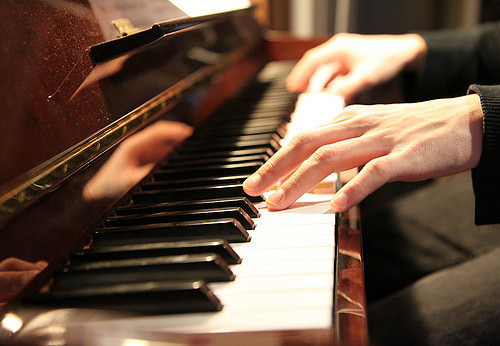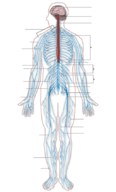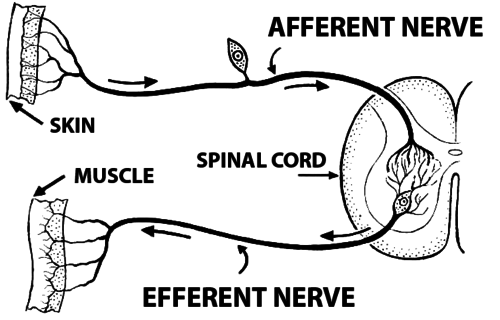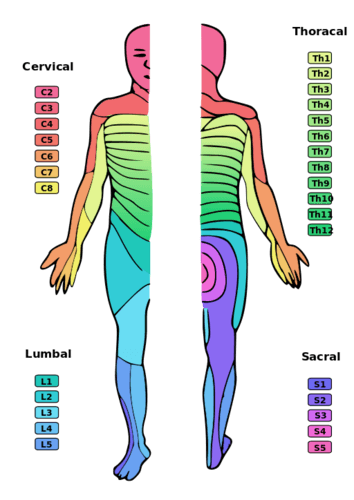10.6 周边神经神经系统
Section outline
-
One Piano, Four Hands
::一钢琴,四手四手Did you ever see two people play the same piano? How do they coordinate all the movements of their own fingers — let alone synchronize them with those of their partner? The peripheral nervous system plays an important part in this challenge.
::你见过两个人弹同一钢琴吗?他们如何协调自己手指的所有运动? 更不要说他们与其伙伴的动作同步了?外围神经系统在这一挑战中起着重要作用。What Is the Peripheral Nervous System?
::什么是周边神经系统?The peripheral nervous system (PNS) consists of all the nervous tissue that lies outside of the (CNS). The main function of the PNS is to connect the CNS to the rest of the organism . It serves as a relay, going back and forth between the CNS and , organs , and glands throughout the body.
::外围神经系统(PNS)由位于(CNS)之外的所有神经组织组成,其主要功能是将CNS连接到其他生物体,作为CNS与整个身体的器官和腺之间的中继器。The nerves of the peripheral nervous system are shown in blue in this figure.
::这个图以蓝色显示外围神经神经系统的神经。Tissues of the Peripheral Nervous System
::周边神经神经系统组织The PNS is mostly made up of cable-like bundles of axons called nerves , as well as clusters of neuronal bodies called ganglia (singular, ganglion ) . Nerves are generally classified as sensory, motor, or mixed nerves based on the direction in which they carry .
::PNS主要由被称为神经的像电缆一样的斧子捆绑组成,以及被称为帮派的神经器官团团组成。 神经一般根据携带方向被归类为感官、运动或混合神经。-
Sensory nerves
transmit information from
sensory receptors
in the body to the CNS. Sensory nerves are also called afferent nerves. You can see an example in the figure
.
::感官神经从身体的感官受体向 CNS 传递信息。感官神经也被称为“远视神经 ” 。 您可以在图中看到一个例子 。 -
Motor nerves
transmit information from the CNS to muscles, organs, and glands. Motor nerves are also called efferent nerves. You can see one in the figure
.
::运动神经将信息从 CNS 传输到肌肉、器官和腺。 运动神经也被称为“ 发热神经 ” 。 您可以在图中看到 。 -
Mixed nerves
contain both sensory and
motor neurons
, so they can transmit information in both directions. They have both afferent and efferent functions.
::混合神经包含感官神经元和运动神经元,因此它们可以双向传递信息。它们既具有超常功能,也具有超常功能。
In this diagram, each nerve is depicted as a single neuron for simplicity. This afferent neuron sends nerve impulses from sensory receptors in the skin to the CNS. The efferent neuron is a motor neuron that sends nerve impulses from the CNS to a muscle. The cell body of the afferent neuron is located in a ganglion (not pictured), while the cell body of the motor neuron is located in the spinal cord.
::在本图中,每个神经被描述为单一神经元,以简单为目的。这个神经元将神经脉冲从皮肤的感应受体传到 CNS。这个神经元是运动神经元,将神经脉冲从 CNS 传到肌肉。一个神经元的细胞体位于一个交织处(没有图解),而运动神经元的细胞体则位于脊髓。Divisions of the Peripheral Nervous System
::周边神经神经系统各分区The PNS is divided into two major systems, called the autonomic nervous system and the somatic nervous system . In the diagram , the autonomic system is shown on the left, and the somatic system on the right. Both systems of the PNS interact with the CNS and include sensory and motor neurons, but they use different circuits of nerves and ganglia.
::PNS分为两大系统,称为自动神经系统和体能神经系统。在图表中,自动系统显示在左侧,体力系统显示在右侧。两种系统都与CNS互动,包括感官神经元和运动神经元,但它们使用不同的神经和帮派电路。The two major divisions of the PNS are the autonomic and sensory nervous systems.
::PNS的两个主要部门是自主和感官神经系统。Somatic Nervous System
::气压系统The somatic nervous system primarily the external environment and controls voluntary activities about which decisions and commands come from the cerebral cortex of the brain . When you feel too warm, for example, you decide to turn on the air conditioner. As you walk across the room to the thermostat, you are using your somatic nervous system. In general, the somatic nervous system is responsible for all of your conscious perceptions of the outside world, as well as all of the voluntary motor activities you perform in response. Whether it’s playing a piano, driving a car, or playing basketball, you can thank your somatic nervous system for making it possible.
::身体神经系统主要是外部环境,控制着由大脑大脑皮层做出决定和命令的自愿活动。例如,当你感到太热时,你决定打开空调。当你穿过房间到自动调温器时,你正在使用身体神经系统。一般而言,身体神经系统负责你对外部世界的所有意识,以及你为回应而从事的所有自愿运动活动。无论是弹钢琴,驾驶汽车,还是打篮球,你都可以感谢你的身体神经系统,因为这个系统是可能的。Somatic sensory and motor information is transmitted through 12 pairs of cranial nerves and 31 pairs of spinal nerves. Cranial nerves are in the head and neck and connect directly to the brain. Sensory components of cranial nerves transmit information about smells, tastes, light, sounds, and body position. Motor components of cranial nerves control of the face, tongue, eyeballs, throat, head, and shoulders. Motor components of cranial nerves also control the salivary glands and swallowing. Four of the 12 cranial nerves participate in both sensory and motor functions as mixed nerves, having both sensory and motor neurons.
::心感官和运动信息通过12对冠状神经和31对脊椎神经传播; 头部和颈部有骨神经,与大脑直接相连; 骨骼神经的感官成分传递有关气味、口味、光、声音和身体位置的信息; 骨骼神经控制面部、舌头、眼球、喉咙、头部和肩膀的机能成分; 脊椎神经的机能成分也控制了唾液腺和吞咽; 12头角神经中有4个具有感官和运动功能,同时具有运动神经和感官。Spinal nerves emanate from the spinal column between vertebrae . All of the spinal nerves are mixed nerves, containing both sensory and motor neurons. The areas of skin innervated by the 31 pairs of spinal nerves are shown in the figure . These include sensory nerves in the skin that sense pressure, temperature, vibrations, and pain. Other sensory nerves are in the muscles, and they sense stretching and tension. Spinal nerves also include motor nerves that stimulate skeletal muscles to contract, allowing for voluntary body movements.
::脊椎骨的脊椎神经。所有脊椎神经都是混合神经,包含感官和运动神经。31对脊椎神经的皮肤内心部部分在图中显示。其中包括皮肤中感应压力、温度、振动和疼痛的感应神经;其他感应神经在肌肉中,它们感觉到伸展和紧张。脊椎神经还包括刺激骨骼肌肉萎缩的运动神经,允许自愿的身体运动。This drawing shows the areas of the skin innervated by sensory spinal nerves of the somatic nervous system. The left half of the figure shows the nerves in the front of the body, and the right half shows the nerves in the back of the body. The area that each spinal nerve innervates is shown in a different color.
::这个图示显示了身体神经系统的感官脊椎神经内心的皮肤部位。 图左半部显示身体前部的神经,右半部显示身体后部的神经。 每个脊椎神经内心部部位的区域以不同颜色显示 。Autonomic Nervous System
::自动神经神经系统The autonomic nervous system primarily senses the internal environment and controls involuntary activities. It is responsible for monitoring conditions in the internal environment and bringing about appropriate changes in them. In general, the autonomic is responsible for all the activities that go on inside your body without your conscious awareness or voluntary participation.
::自主神经系统主要是感知内部环境和控制非自愿活动,负责监测内部环境的条件,并进行适当改变,一般而言,自主神经系统负责在没有意识或自愿参与的情况下在身体内进行的所有活动。Structurally, the autonomic nervous system consists of sensory and motor nerves that run between the CNS (especially the hypothalamus in the brain), internal organs (such as the heart, lungs , and digestive organs), and glands (such as the pancreas and sweat glands). Sensory neurons in the autonomic system detect internal body conditions and send messages to the brain. Motor nerves in the autonomic system affect appropriate responses by controlling contractions of smooth or cardiac muscle , or glandular tissue . For example, when sensory nerves of the autonomic system detect a rise in body temperature, motor nerves signal smooth muscles in near the body surface to undergo vasodilation, and the sweat glands in the skin to secrete more sweat to cool the body.
::从结构上讲,自体神经系统由感官和运动神经组成,在CNS(特别是脑中的低丘脑)、内器官(如心脏、肺和消化器官)和腺(如胰腺和汗腺)之间运行。自体神经系统由感官和运动神经组成,在结构上由感官和运动神经组成。自体系统中的感官神经检测身体内部状况并向大脑发送信息。自体系统中的动神经通过控制光滑或心肌或腺组织收缩影响适当的反应。例如,当自体系统的感官神经检测到身体温度上升时,运动神经信号在身体表面附近的光滑肌肉将经历血管变异,皮肤上的汗腺将更多的汗液隐藏到身体冷却。The autonomic nervous system, in turn, has three subdivisions: the sympathetic division , parasympathetic division , and enteric division. The first two subdivisions of the autonomic system are summarized in the figure . Both affect the same organs and glands, but they generally do so in opposite ways.
::自主神经系统则由三个分支组成:同情分裂、寄生虫病分和肠道分。图中总结了自主系统前两个分支。两者都影响同样的器官和腺,但它们通常以相反的方式发生。-
The
sympathetic division
controls the fight-or-
flight
response. Changes occur in organs and glands throughout the body that prepare the body to fight or flee in response to a perceived danger. For example, the heart rate speeds up, air passages in the lungs become wider, more
flows to the skeletal muscles, and the
temporarily shuts down.
::同情的师师控制着战斗或飞行反应。 身体的器官和腺的变化会发生,身体的器官和腺会做好准备,应对所察觉的危险而进行战斗或逃跑。 比如,心跳加速,肺部的空气通道扩大,更多的空气流向骨骼肌肉,暂时关闭。 -
The
parasympathetic division
returns the body to normal after the fight-or-flight response has occurred. For example, it slows down the heart rate, narrows air passages in the lungs, reduces blood flow to the skeletal muscles, and stimulates the digestive system to start working again. The parasympathetic division also maintains internal
of the body at other times.
::寄生虫病分解使身体在战斗或飞行反应发生后恢复正常。 例如,它减慢心跳,缩小肺气道,减少血液流到骨骼肌肉,刺激消化系统重新开始工作。 寄生虫病分解还保持了身体的内部。 -
The
enteric division
is made up of nerve fibers that supply the organs of the digestive system. This division allows for the local control of many digestive functions.
::肠道分解由神经纤维组成,提供消化系统的器官。这个分解可以让当地控制许多消化功能。
This diagram summarizes the structures and functions controlled by the parasympathetic and sympathetic divisions of the autonomic nervous system.
::该图概述了由自主神经系统的寄生虫和同情分系控制的结构和功能。Disorders of the Peripheral Nervous System
::周边神经神经系统紊乱Unlike the CNS — which is protected by , meninges, and cerebrospinal fluid — the PNS has no such protections. The PNS also has no blood-brain barrier to protect it from toxins and in the blood. Therefore, the PNS is more subject to injury and disease than is the CNS. Causes of nerve injury include , (such as shingles), and poisoning by toxins (such as heavy metals). PNS disorders often have symptoms like loss of feeling, tingling, burning sensations, or muscle weakness. If a traumatic injury results in a nerve being transected (cut all the way through), it may regenerate, but this is a very slow process and may take many months.
::与受神经、脑膜和脑脊髓液保护的CNS不同,PNS没有这种保护,PNS也没有防血脑障碍来保护它不受毒素和血液的伤害和疾病,因此,PNS比CNS更容易受到伤害和疾病。神经伤害的原因包括(如闪烁)和毒素中毒(如重金属),PNS的症状往往有失去感觉、发作、发作、感官或肌肉虚弱等症状。如果创伤伤害导致神经切除(通过切开),它可能会再生,但这是一个非常缓慢的过程,可能需要好几个月时间。Two other diseases of the PNS are Guillain-Barre syndrome and Charcot-Marie-Tooth disease.
::PNS的另外两种疾病是吉卜赛-巴雷综合症和Charcot-Marie-Tooth疾病。-
Guillain-Barre syndrome is a rare disease in which the
immune system
attacks nerves of the PNS, leading to muscle weakness and even paralysis. The exact cause of Guillain-Barre syndrome is unknown, but it often occurs after a viral or bacterial infection. There is no known cure for the syndrome, but most people eventually make a full recovery. Recovery can be slow, however, lasting anywhere from several weeks to several years.
::吉卜赛-巴雷综合症是一种罕见的疾病,其免疫系统会攻击PNS神经,导致肌肉虚弱甚至瘫痪。 吉卜赛-巴雷综合症的确切原因并不为人所知,但往往是在病毒或细菌感染后发生的。 综合症没有已知的治疗方法,但大多数人最终会完全康复。 然而,恢复速度可能缓慢,从几周到几年不等。 -
Charcot-Marie-Tooth disease is a hereditary disorder of the nerves, and one of the most common inherited neurological disorders. It affects predominantly the nerves in the feet and legs,
and often
in the hands and arms, as well. The disease is characterized by loss of
muscle tissue
and sense of touch. It is presently incurable.
::Charcot-Marie-Tooth疾病是一种遗传性神经紊乱症,也是最常见的遗传性神经系统紊乱症之一,主要影响脚和腿的神经,也经常影响手和手臂的神经,其特点是肌肉组织丧失和触摸感,目前无法治愈。
Feature: My Human Body
::特质:我的人体The autonomic nervous system is considered to be involuntary because it doesn't require conscious input. However, it is possible to exert some voluntary control over it. People who practice yoga or other so-called mind-body techniques, for example, can reduce their heart rate and certain other autonomic functions. Slowing down these otherwise involuntary responses is a good way to relieve stress and reduce the wear-and-tear that stress can place on the body. Such techniques may also be useful for controlling post-traumatic stress disorder and chronic pain. Three types of integrative practices for these purposes are exercises, body-based tension modulation exercises, and mindfulness techniques.
::自动神经系统被认为是非自愿的, 因为它不需要有意识的投入。 但是, 可以对它进行某种自愿控制。 例如, 做瑜伽或其他所谓的心身技术的人可以降低心率和某些其他自体功能。 减慢这些非自愿反应是缓解压力和减少身体压力的磨损的好方法。 这些技术也可以用于控制创伤后应激障碍和慢性疼痛。 用于这些目的的三种综合做法是练习、 身体压力调制练习和注意技巧。Breathing exercises can help control the rapid, shallow breathing that often occurs when you are anxious or under stress. These exercises can be learned quickly, and they provide immediate feelings of relief. Specific breathing exercises include paced breath, diaphragmatic breathing, and Breathe2Relax, which is a computerized breathing practice program. You can access the Breathe2Relax program with this online video:
::呼吸练习可以帮助控制在焦虑或压力下经常发生的快速、浅薄的呼吸。这些练习可以快速地学习,并且能立即提供解脱感。具体的呼吸练习包括呼吸节奏、隔膜呼吸和呼吸2Relax,这是一个计算机化的呼吸练习程序。您可以通过这个在线视频访问呼吸2Relax程序:Body-based tension modulation exercises include yoga postures (also known as “asanas”) and tension manipulation exercises. The latter include the Trauma/Tension Release (TRE) and the Trauma Resiliency Model (TRM). Watch this video for a brief — but informative — introduction to the TRE program:
::以身体为基础的紧张调控练习包括瑜伽姿势(又称“麻疯”)和紧张操纵练习,后者包括创伤/感应释放(TRE)和创伤恢复模型(TRM)。Mindfulness techniques have been shown to reduce symptoms of depression, as well as those of anxiety and stress. They have also been shown to be useful for pain management and performance enhancement. Specific mindfulness programs include Mindfulness Based Stress Reduction (MBSR) and Mindfulness Mind- Fitness Training (MMFT). You can learn more about MBSR by watching the video below.
::为减少抑郁症状以及焦虑和压力症状,已经展示了记念技术,也证明这些技术有助于疼痛管理和提高性能,具体的记念方案包括减少记念压力和心知力培训(MMFT),通过观看下面的录像,可以了解更多关于MBSR的信息。Summary
::摘要-
The peripheral nervous system (PNS) consists of all the nervous tissue that lies outside the central nervous system (CNS). Its main function is to connect the CNS to the rest of the organism.
::外围神经系统(PNS)由中央神经系统以外的所有神经组织组成,其主要功能是将CNS与生物体的其他部分连接起来。 -
The PNS is made up of nerves and ganglia. Nerves are bundles of axons, and ganglia are groups of cell bodies. Nerves are classified as sensory , motor, or a mix of the two.
::PNS是由神经和帮派组成的。 Nerves是斧子的捆绑,而 banglia是细胞身体的组合。 Nerves被归类为感官、马达或两者的混合体。
::PNS是由神经和帮派组成的。 Nerves是斧子的捆绑,而 banglia是细胞身体的组合。 Nerves被归类为感官、马达或两者的混合体。 -
The PNS is divided into the somatic and autonomic nervous systems. The somatic system controls voluntary activities, whereas the autonomic system controls involuntary activities.
::PNS分为体能和自主神经系统,体能系统控制自愿活动,而自动系统控制非自愿活动。 -
The autonomic nervous system is further divided into sympathetic, parasympathetic, and enteric divisions. The sympathetic division controls fight-or-flight responses during emergencies, the parasympathetic system controls routine body functions the rest of the time, and the enteric division provides local control over the digestive system.
::自主神经系统进一步分为同情、寄生虫病和肠道分裂。 同情性分裂控制紧急情况下的战斗或飞行反应,寄生虫病系统控制常规身体功能剩余时间,肠道分裂控制消化系统的地方控制。 -
The PNS is not as well protected physically or chemically as the CNS, so it is more prone to injury and disease. PNS problems include injury from diabetes, shingles, and heavy metal poisoning. Two disorders of the PNS are Guillain-Barre syndrome and Charcot-Marie-Tooth disease.
::PNS在身体或化学上没有像CNS那样受到良好的保护,因此更容易受伤和患病。 PNS的问题包括糖尿病、发青和重金属中毒造成的伤害。 PNS的两种疾病是Gelain-Barre综合症和Charcot-Marie-Tooth病。
Review
::回顾1, Describe the general structure of the peripheral nervous system. State its primary function.
::1. 描述外围神经系统的一般结构,说明其主要功能。2. What are ganglia?
::2. 什么是帮凶?3. Identify three types of nerves based on the direction in which they carry nerve impulses.
::3. 根据其携带神经冲动的方向,查明三种类型的神经。4. Outline all of the divisions of the peripheral nervous system.
::4. 概述外围神经系统的所有部分。5. Compare and contrast the somatic and autonomic nervous systems.
::5. 比较和比较体能和自主神经系统。6. When and how does the sympathetic division of the autonomic nervous system affect the body?
::6. 自主神经系统的同情分化何时和如何影响身体?7. What is the function of the parasympathetic division of the autonomic nervous system? Specifically, how does it affect the body?
::7. 自主神经系统寄生虫病分解的功能是什么?具体而言,它如何影响身体?8. N ame and describe two peripheral nervous system disorders.
::8. 列出并描述两种外围神经系统紊乱。9. Give one example of how the CNS interacts with the PNS to control a function in the body.
::9. 请举一个例子,说明CNS如何与PNS互动,以控制体内的功能。10. For each of the following types of information, identify whether the neuron carrying it is sensory or motor, and whether it is most likely in the somatic or autonomic nervous system.
::10. 对于以下每一种信息,应查明携带神经元的神经元是感官还是运动,以及是否最有可能存在于体外神经系统还是自主神经系统。a. visual information
::a. 视觉信息b. blood pressure information
::b. 血压信息c. information that causes muscle contraction in digestive organs after eating
::c. 导致食后消化器官肌肉萎缩的信息d. information that causes muscle contraction in skeletal muscles based on the person’s decision to make a movement
::d. 根据个人运动决定导致骨骼肌肉肌肉萎缩的信息11. The cranial nerves...
::11 头骨神经...a. carry sensory information
::a. 携带感官信息b. carry motor information
::b. 携带发动机信息c. are part of the somatic nervous system
::c. 是体神经系统的一部分d. all of the above
::d. 以上所有情况12 . True or False: All of the spinal nerves carry both sensory and motor information.
::12. 真实或假:所有脊椎神经都包含感官和运动信息。13. True or False: The sympathetic nervous system enhances digestion to provide more energy for the body.
::13. 真实或假:同情的神经系统会增强消化能力,为身体提供更多能量。Explore More
::探索更多Phantom limbs are the sensations of feeling body parts — like arms or hands — that aren't on your body because they are amputated or missing. Learn more about phantom limbs here:
::幻肢是一种感觉身体部位的感官——如手或手——不是放在你身体上,因为它们被截肢或失踪。Ever wonder why "hot" peppers are perceived as hot? Check out this link:
::为何热辣椒被认为是热辣椒? -
Sensory nerves
transmit information from
sensory receptors
in the body to the CNS. Sensory nerves are also called afferent nerves. You can see an example in the figure
.





